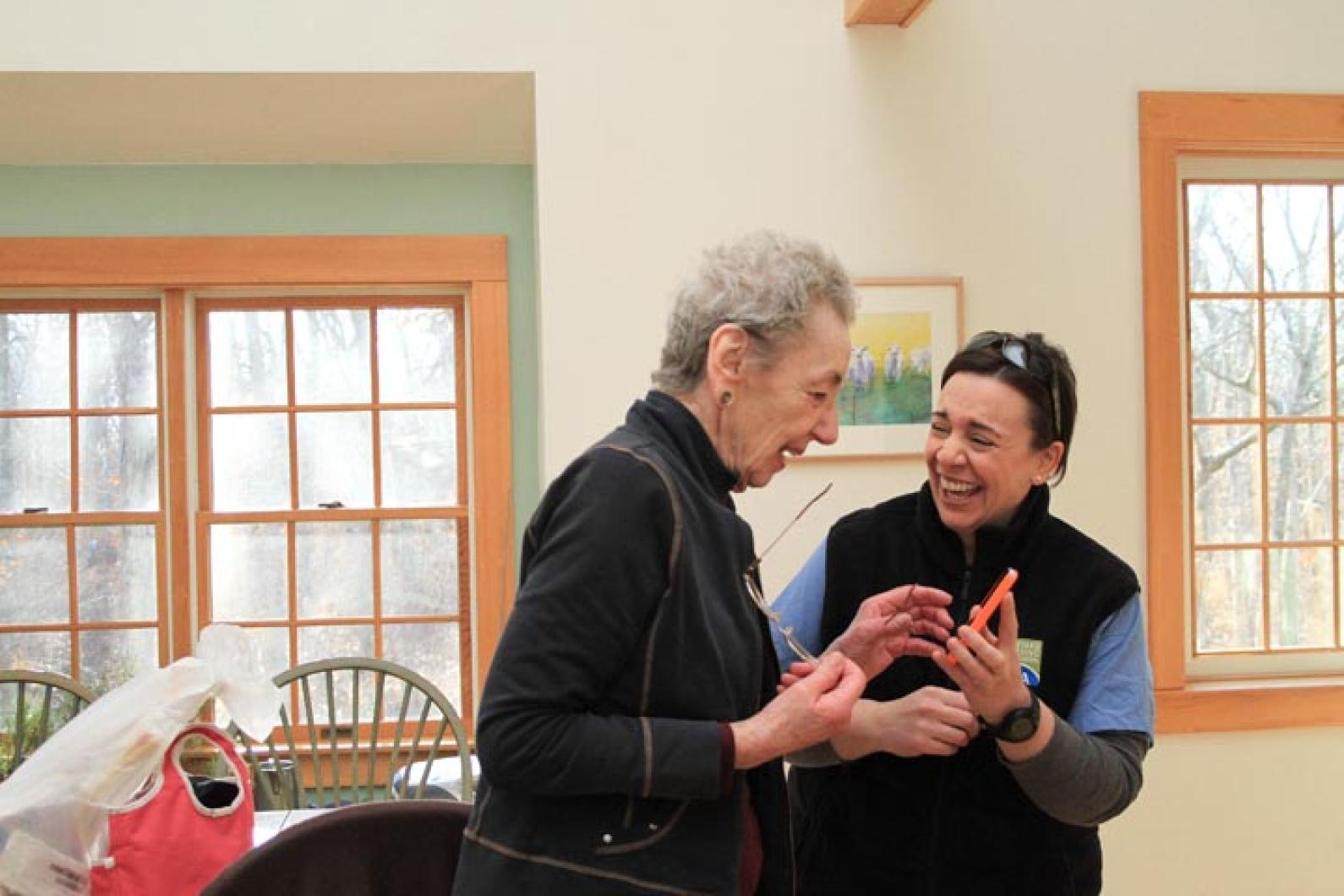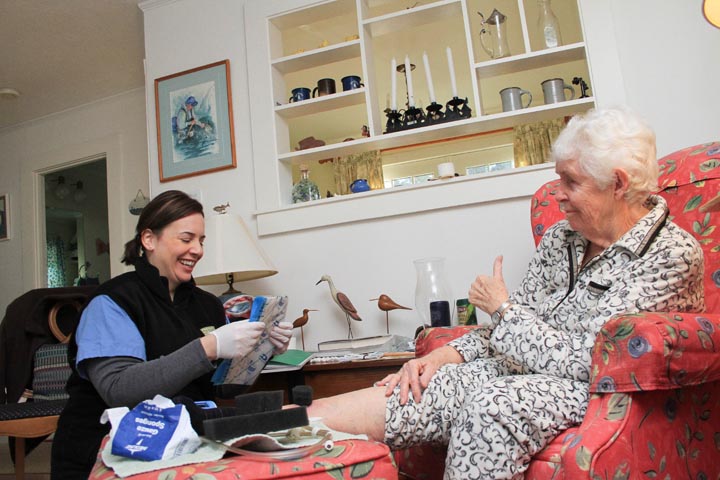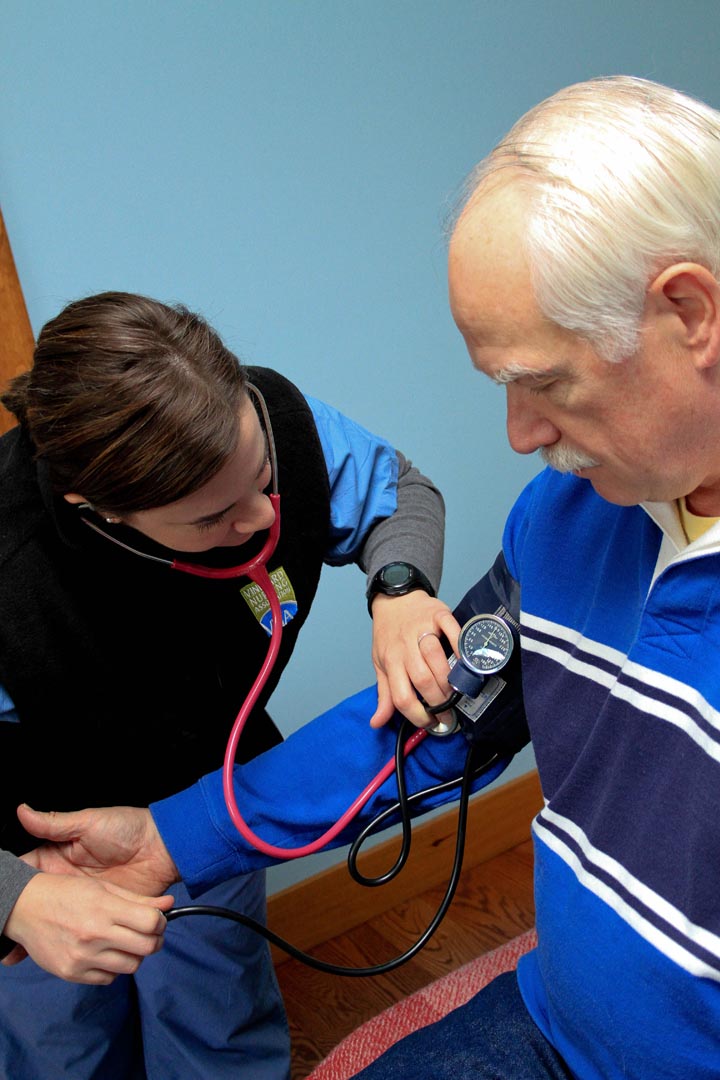On a recent Monday morning, visiting nurse Kristine Cammorata attended to Marcia MacGillivray at her home in Vineyard Haven to check on a melanoma recently removed from her shin. Mrs. MacGillivray had called the Vineyard Nursing Association (VNA) the previous weekend because she thought the wound was looking too red and puffy.
“See how it’s bleeding? Bleeding is good, that means it’s nice and healthy tissue,” Ms. Cammorata told her patient. Ms. Cammorata has been visiting Mrs. MacGillivray a few times a week to help with the wound.
Few things shock Ms. Cammorata, including Mrs. MacGillivray’s deep wound. Ms. Cammorata is a former Oak Bluffs police officer and three years ago she thought becoming a visiting nurse would be good way to take public service to a different level. And Mrs. MacGillivray, for one, is glad she did.
“I never knew how great it was to have the VNA. Any concern, I call and in five minutes someone is calling me back and within a half an hour they’re here,” she said.
“That’s the biggest thing when we have new patients – we tell them no question is too silly,” Ms. Cammorata said. “If we can’t fix it over the phone, the on-call nurse will come out.”
Ms. Cammorata thought the wound was healing nicely. Mrs. MacGillivray commented on how the surgery had changed her lifestyle dramatically, and how thankful she was for the VNA.
“This is just a little blip,” Ms. Cammorata said placing a piece of medical foam over Mrs. MacGillivray’s wound on her shin.
“Yes, it is a little blip,” Mrs. MacGillivray replied, and turned her attention to a more pressing matter — Ms. Cammorata’s newborn son. “What new and exciting thing has Matthew done?” she asked.
“I gave him cereal this week,” Ms. Cammorata said with a grin, as she placed a piece of plastic over the foam and connected it to a vacuum mechanism that sealed it tight.
After leaving Mrs. MacGillivray’s house, Ms. Cammorata said, “You want to teach them, but at the same time it can be so overwhelming for people, especially if it’s a new diagnosis. You don’t want to throw too much at them — the less technical the better. I think what I try to do and a lot of us do, you bring one thing each time.”
And if Ms. Cammorata is unsure about something, she knows she can always call in for another opinion.
“We do rely very heavily on each other at times and that’s what we’re all there for,” she said. “I feel very supported. It’s a good environment; we all help each other.”
The VNA provides nurses, physical therapy, home health aides and medical social work in upwards of 40,000 visits a year. Those visits range as widely in age as they do in ailments, anything from checking on a grieving widow in her 80s with high blood pressure to changing an intravenous line in an 18-year-old.
To meet that growing need, the VNA expanded services to Nantucket last February and increased staff dramatically. In the last five years, staff has grown from 35 to 100, 85 of whom are stationed on the Vineyard.
Demand for home health services is expected to grow here, especially with a growing elderly population, VNA chief executive officer Robert Tonti said this week. In the 2010 census, Dukes County was marked as the fastest-growing county in the state for people 65 and over, and by 2020, that population is expected to double.
“What that tells us is that we are a retirement destination,” Mr. Tonti said. “Nationally as that bubble moves through the population we will see it grow normally . . . but on the Vineyard that demand will be even more because people are retiring here. They may just be here for six months but that’s still six months we have to cover.”
Patient Allen Janger and his wife, Inez, chose to move to West Tisbury from New York 16 years ago because of the options provided by the VNA. Mr. Janger has a degenerative spinal condition that has left him wheelchair-bound. On Monday Ms. Cammorata was on hand to change a catheter.
“How are you feeling, Allen?” she asked.
“Better than good,” he replied.
Mr. Janger and Ms. Cammorata went into the next room to change the catheter, and Mrs. Janger reflected on their time with the VNA.
“Here he can go to the Oak Bluffs library, the Howes House . . . and he would have never have gotten that level of independence in New York,” Mrs. Janger said. “This is easier. [The VNA] has been terrific.”
Patients are referred to the VNA after hospital visits or by doctors. The majority of VNA cases are handled through Medicare and are treated on an episodic model, where the more difficult cases have higher reimbursements for a fixed amount, and that money is good for 60 days. It’s then up to the VNA to figure out the care plan and how many visits can be made within the budget. After 60 days the patient can reapply for an additional 60 days of care. About 80 per cent of cases are closed after the 120-day period; longer cases like Mr. Janger’s are recertified for long term care management plans.
Home care is a delicate balance of serving the patient and building a rapport with them while keeping an emotional distance, Ms. Cammorata said, and to do that she keeps the focus on the patient’s goals of getting better and feeling comfortable during the recovery.
“We have to be mindful of being too familiar, wanting to care for them while remaining professional,” she said. “We try to leave them a little bit better off than we found them, maybe teach them more effective ways to manage their illness or teach what they can do to improve their quality of life.”
John Caldwell’s quality of life has improved dramatically with Ms. Cammorata’s help and other services from the VNA. Mr. Caldwell, who lives in Oak Bluffs, had hip replacement surgery, and today he was “graduating,” only after one last finger prick to test his blood coagulation.
“My father had the same issue 40 years ago, he got a cane and I got a new hip,” Mr. Caldwell said. “The VNA has been wonderful. They’ve been an important part of my recovery.”
Ms. Cammorata has been monitoring Mr. Caldwell to make sure he doesn’t have a blood clot, one of the risks of the hip replacement surgery.
“All right, quick pinch,” she warned before taking blood. “I think you’re going to be just fine.”
“Thank you, mom,” was the reply.
Joint replacements, diabetes and heart issues are a handful of issues the VNA sees on a growing basis, Mr. Tonti said. The management of chronic diseases — and how they are addressed by Medicare —is an issue on the horizon.
“There’s an emerging view that today in the world of home care, Medicare only deals with acute cases,” he said, explaining that after a patient is stable they are often no longer entitled to home care under Medicare. ”They leave our care, start taking medication improperly or not eating well and then there’s another acute episode and they end up back in the hospital.”
This acute-to-chronic condition cycle needs to be better managed, Mr. Tonti said, and in a preventative way.
“How do we stop people needlessly using hospitals . . . if they were taking their medication properly it wouldn’t have happened,” he continued.
Home care is the cheapest option, Mr. Tonti said, and the goal is to keep patients safe in their home and be able to manage chronic diseases, he said.
“By monitoring them and making sure they take their medication and their house is safe — these are things we can control,” Mr. Tonti said.
After the VNA’s help, Mrs. MacGillivray is now back at work and discharged from the agency.
“I told her if at any point she doesn’t like the looks of the wound she can stop by the agency and we’ll take a peek,” said Ms. Cammorata, who added, however, that “The wound looks beautiful.”







Comments (3)
Comments
Comment policy »